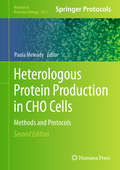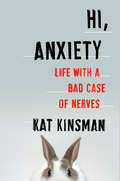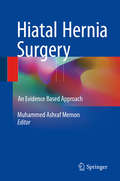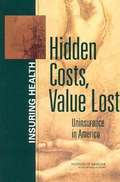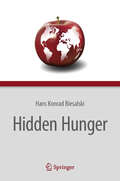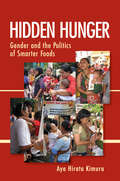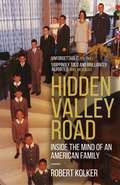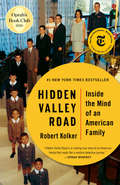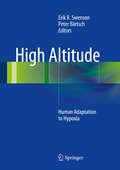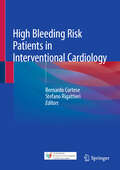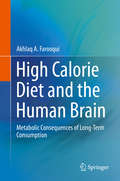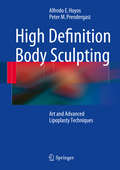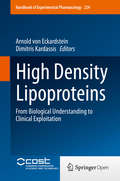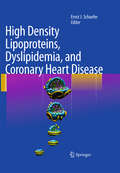- Table View
- List View
Heterologous Protein Production in CHO Cells: Methods and Protocols (Methods in Molecular Biology #2853)
by Paula MeleadyThis detailed new edition explores the use of Chinese hamster ovary (CHO) cells in the production of therapeutic protein products. Beyond updates on earlier methodologies, the book also delves into the genetic manipulation of CHO cells for recombinant protein production, analysis of CHO cells using proteomic and metabolomic approaches, as well as methods for the characterization of recombinant protein products, such as glycosylation and host cell protein analysis. Written for the highly successful Methods in Molecular Biology series, chapters include introductions to their respective topics, lists of the necessary materials and reagents, step-by-step and readily reproducible laboratory protocols, and tips on troubleshooting and avoiding known pitfalls. Authoritative and up-to-date, Heterologous Protein Production in CHO Cells: Methods and Protocols, Second Edition is an ideal guide for researchers working to enhance and accelerate CHO productive capabilities in the coming decades.
Heterosexual Africa?: The History Of An Idea From The Age Of Exploration To The Age Of Aids (New African Histories)
by Marc EpprechtHeterosexual Africa? The History of an Idea from the Age of Exploration to the Age of AIDS builds from Marc Epprecht’s previous book, Hungochani (which focuses expli citly on same-sex desire in southern Africa) to explore the historical processes by which a singular, heterosexual identity for Africa was constructed—by anthropologists, ethnopsychologists, colonial officials, African elites, and most recently, health care workers seeking to address the HIV/AIDS pandemic. This is an eloquently written, accessible book, based on a rich and diverse range of sources, that will find enthusiastic audiences in classrooms and in the general public. Epprecht argues that Africans, just like people all over the world, have always had a range of sexualities and sexual identities. Over the course of the last two centuries, however, African societies south of the Sahara have come to be viewed as singularly heterosexual. Epprecht carefully traces the many routes by which this singularity, this heteronormativity, became a dominant culture. A fascinating story that will surely generate lively debate Epprecht makes his project speak to a range of literatures—queer theory, the new imperial history, African social history, queer and women’s studies, and biomedical literature on the HIV/AIDS pandemic. He does this with a light enough hand that his story is not bogged down by endless references to particular debates. Heterosexual Africa? aims to understand an enduring stereotype about Africa and Africans. It asks how Africa came to be defined as a “homosexual-free zone” during the colonial era, and how this idea not only survived the transition to independence but flourished under conditions of globalization and early panicky responses to HIV/AIDS.
Hexapod External Fixator Systems: Principles and Current Practice in Orthopaedic Surgery
by Marco Massobrio Redento MoraThis book provides a thorough description of hexapod external fixators, from the theoretical basis to their practical application. Indications and practical use in current Orthopaedic practice are addressed in detail, offering the reader essential insights into the strengths and limitations of these devices. The main aspects covered, include primary (congenital) and secondary (acquired) deformities of the limbs: the etiology, pathomechanics, clinics, technical “tips and tricks” and suggested frame assemblies are presented.Each chapter addresses a specific Orthopaedic problem and includes representative clinical cases commented on by the authors. Illustrations and X-ray images support the discussion of the various themes treated in the textbook. Special attention is also given to deformity morphology and the consequent geometry of correction, as well as economical aspects and the biological risks of radiation exposure. A review of current nomenclature in external fixation is also provided as a quick-reference resource.Offering clear and straightforward descriptions of these devices and their current use in practice, prepared by leading international experts, this book will benefit expert surgeons and residents alike.
Hi, Anxiety: Life With a Bad Case of Nerves
by Kat KinsmanJoining the ranks of such acclaimed accounts as Manic, Brain on Fire, and Monkey Mind, a deeply personal, funny, and sometimes painful look at anxiety and its impact from writer and commentator Kat Kinsman.Feeling anxious? Can't sleep because your brain won't stop recycling thoughts? Unable to make a decision because you're too afraid you'll make the wrong one? You're not alone.In Hi, Anxiety, beloved food writer, editor, and commentator Kat Kinsman expands on the high profile pieces she wrote for CNN.com about depression, and its wicked cousin, anxiety. Taking us back to her adolescence, when she was diagnosed with depression at fourteen, Kat speaks eloquently with pathos and humor about her skin picking, hand flapping, "nervousness" that made her the recipient of many a harsh taunt. With her mother also gripped by depression and health issues throughout her life, Kat came to live in a constant state of unease--that she would fail, that she would never find love . . . that she would end up just like her mother.Now, as a successful media personality, Kat still battles anxiety every day. That anxiety manifests in strange, and deeply personal ways. But as she found when she started to write about her struggles, Kat is not alone in feeling like the simple act of leaving the house, or getting a haircut can be crippling. And though periodic medication, counseling, a successful career and a happy marriage have brought her relief, the illness, because that is what anxiety is, remains.Exploring how millions are affected anxiety, Hi, Anxiety is a clarion call for everyone--but especially women--struggling with this condition. Though she is a strong advocate for seeking medical intervention, Kinsman implores those suffering to come out of the shadows--to talk about their battle openly and honestly. With humor, bravery, and writing that brings bestsellers like Laurie Notaro and Jenny Lawson to mind, Hi, Anxiety tackles a difficult subject with amazing grace.
Hiatal Hernia Surgery
by Muhammad Ashraf MemonThis book aims to address the recent advances and controversies on the subject of hiatus hernia and antireflux surgery. The field of antireflux surgery is undergoing a lot of changes, and traditional concepts are being challenged. The readers are provided with an evidence based approach to assist surgeons' decisions in developing a preoperative investigative algorithm prior to offering a surgical solution for either primary or recurrent hiatal hernia surgery based on supporting evidence. The chapters will further investigate the latest trends in minimally invasive hiatal hernia and antireflux surgery, both for primary and recurrent hernias.
Hidden Costs, Values Lost: Uninsurance in America
by Committee on the Consequences of UninsuranceHidden Cost, Value Lost, the fifth of a series of six books on the consequences of uninsurance in the United States, illustrates some of the economic and social losses to the country of maintaining so many people without health insurance. The book explores the potential economic and societal benefits that could be realized if everyone had health insurance on a continuous basis, as people over age 65 currently do with Medicare. Hidden Costs, Value Lost concludes that the estimated benefits across society in health years of life gained by providing the uninsured with the kind and amount of health services that the insured use, are likely greater than the additional social costs of doing so. The potential economic value to be gained in better health outcomes from uninterrupted coverage for all Americans is estimated to be between $65 and $130 billion each year.
Hidden Heroes: America's Military Caregivers
by Terri Tanielian Rajeev Ramchand Michael P. Fisher Christine Anne Vaughan Thomas E. Trail Caroline Epley Phoenix Voorhies Michael William Robbins Eric Robinson Bonnie Ghosh-DastidarLittle has been reported about "military caregivers"--the population of those who care for wounded, ill, and injured military personnel and veterans. This report summarizes the results of a study designed to describe the magnitude of military caregiving in the United States today, as well as to identify gaps in the array of programs, policies, and initiatives designed to support military caregivers.
Hidden Histories of the Dead: Disputed Bodies in Modern British Medical Research
by Elizabeth T. HurrenIn this discipline-redefining book, Elizabeth T. Hurren maps the post-mortem journeys of bodies, body-parts, organs, and brains, inside the secretive culture of modern British medical research after WWII as the bodies of the deceased were harvested as bio-commons. Often the human stories behind these bodies were dissected, discarded, or destroyed in death. Hidden Histories of the Dead recovers human faces and supply-lines in the archives that medical science neglected to acknowledge. It investigates the medical ethics of organ donation, the legal ambiguities of a lack of fully-informed consent and the shifting boundaries of life and re-defining of medical death in a biotechnological era. Hurren reveals the implicit, explicit and missed body disputes that took second-place to the economics of the national and international commodification of human material in global medical sciences of the Genome era. This title is also available as Open Access.
Hidden Hunger
by Hans Konrad Biesalski Patrick O'MealyHidden Hunger is an increasing problem even in developed countries, whose potential negative consequences on long-term health are often overlooked and underestimated. Chronic malnutrition is at the core of the global hunger challenge facing science, politics, and economics. In plain language and with moving examples, Hans K. Biesalski describes how hidden hunger affects human health long before malnutrition becomes obvious. Worldwide, over one third of deaths among children under 5 years of age is associated with malnutrition. As poverty is the main reason for hidden hunger, addressing this dire challenge requires long-term policies. Land grabbing and climate change seriously counteract a lot of efforts to overcome hidden hunger. This book is a highly impressive call to action. Investment in agriculture and in particular in small-scale farmers to improve subsistence farming are among the approaches suggested to reach a sustainable solution. The author is head of the department of biochemistry and nutrition and managing director of the Food Security Center at the University of Hohenheim, Germany. He is a member of numerous advisory and expert groups for the World Health Organization (WHO), the Food and Agriculture Organization (FAO) and the Global Forum on Food Security and Nutrition.
Hidden Hunger: Gender and the Politics of Smarter Foods
by Aya Hirata KimuraFor decades, NGOs targeting world hunger focused on ensuring that adequate quantities of food were being sent to those in need. In the 1990s, the international food policy community turned its focus to the "hidden hunger" of micronutrient deficiencies, a problem that resulted in two scientific solutions: fortification, the addition of nutrients to processed foods, and biofortification, the modification of crops to produce more nutritious yields. This hidden hunger was presented as a scientific problem to be solved by "experts" and scientifically engineered smart foods rather than through local knowledge, which was deemed unscientific and, hence, irrelevant. In Hidden Hunger, Aya Hirata Kimura explores this recent emphasis on micronutrients and smart foods within the international development community and, in particular, how the voices of women were silenced despite their expertise in food purchasing and preparation. Kimura grounds her analysis in case studies of attempts to enrich and market three basic foods-rice, wheat flour, and baby food-in Indonesia. She shows the power of nutritionism and how its technical focus enhanced the power of corporations as a government partner while restricting public participation in the making of policy for public health and food. She also analyzes the role of advertising to promote fortified foodstuffs and traces the history of Golden Rice, a crop genetically engineered to alleviate vitamin A deficiencies. Situating the recent turn to smart food in Indonesia and elsewhere as part of a long history of technical attempts to solve the Third World food problem, Kimura deftly analyzes the intersection of scientific expertise, market forces, and gendered knowledge to illuminate how hidden hunger ultimately defined women as victims rather than as active agents.
Hidden Pathways to Extinction (Fascinating Life Sciences)
by Giovanni StronaThis book provides, for the first time, a comprehensive overview of the fundamental roles that ecological interactions play in extinction processes, bringing to light an underground of hidden pathways leading to the same dark place: biodiversity loss.We are in the midst of the sixth mass extinction. We see species declining and vanishing one after another. Poached rhinos, dolphins and whales slaughtered, pandas surviving only in captivity are strong emotional testimonials of what is happening. Yet, the main threat to natural communities may be overshadowed by the disappearance of large species, with most extinctions happening unnoticed and involving less eye-catching organisms, such as parasites and pollinators. Ecosystems hide countless, invisible wires connecting organisms in dense networks of ecological interactions. Through these networks, perturbations can propagate from one species to another, producing unpredictable effects. In worst case scenarios, the loss of one species might doom many others to extinction. Ecologists now consider such mechanisms as a fundamental – and still poorly understood - driver of the ongoing biodiversity crisis. Hidden Pathways to Extinction makes the invisible links connecting the fates of species and organisms evident, exploring why complexity can enhance ecosystem stability and yet accelerate species loss. Page after page, Strona provides convincing evidence that we are primarily responsible for the fall in biodiversity, that we are falling too, and that we need to redouble our conservation efforts now, or it won't be long before we hit the ground.
Hidden Valley Road
by Robert Kolker12 children.6 of them diagnosed with schizophrenia.Science's greatest hope in understanding the disease.___________*ONE OF BARACK OBAMA'S FAVOURITE BOOKS OF 2020**TIME 100 Must-Read Books Of 2020 Pick**New York Times bestseller**Selected as Oprah's Book Club Pick*'Startlingly intimate' - The Sunday Times'Grippingly told and brilliantly reported' - Mail on Sunday'Unforgettable' - The TimesFor fans of Educated, The Immortal Life of Henrietta Lacks and Three Identical StrangersDon and Mimi Galvin seemed to be living the American dream. After World War II, Don's work with the Air Force brought them to Colorado, where their twelve children perfectly spanned the baby boom: the oldest born in 1945, the youngest in 1965. In those years, there was an established script for a family like the Galvins - aspiration, hard work, upward mobility, domestic harmony - and they worked hard to play their parts. But behind the scenes was a different story: psychological breakdown, sudden shocking violence, hidden abuse. By the mid-1970s, six of the ten Galvin boys, one after the other, were diagnosed as schizophrenic. How could all this happen to one family?What took place inside the house on Hidden Valley Road was so extraordinary that the Galvins became one of the first families to be studied by the National Institutes of Mental Health. Their story offers a shadow history of the science of schizophrenia, from the era of institutionalization, lobotomy, and the schizophrenogenic mother, to the search for genetic markers for the disease, always amidst profound disagreements about the nature of the illness itself. And unbeknownst to the Galvins, samples of their DNA informed decades of genetic research that continues today, offering paths to treatment, prediction, and even eradication of the disease for future generations.With clarity and compassion, bestselling and award-winning author Robert Kolker uncovers one family's unforgettable legacy of suffering, love and hope.'An extraordinary case study and tour de force of reporting' - Sylvia Nasar, author of A Beautiful Mind'This book tore my heart out. It is a revelation-about the history of mental health treatment, about trauma, foremost about family-and a more-than-worthy follow-up to Robert Kolker's brilliant Lost Girls' -Megan Abbott, Edgar Award-winning author of Dare Me and Give Me Your Hand'Hidden Valley Road contains everything: scientific intrigue, meticulous reporting, startling revelations, and, most of all, a profound sense of humanity. It is that rare book that can be read again and again'-David Grann, author of Killers of the Flower Moon
Hidden Valley Road
by Robert Kolker12 children.6 of them diagnosed with schizophrenia.Science's greatest hope in understanding the disease.___________*ONE OF BARACK OBAMA'S FAVOURITE BOOKS OF 2020**TIME 100 Must-Read Books Of 2020 Pick**New York Times bestseller**Selected as Oprah's Book Club Pick*'Startlingly intimate' - The Sunday Times'Grippingly told and brilliantly reported' - Mail on Sunday'Unforgettable' - The TimesFor fans of Educated, The Immortal Life of Henrietta Lacks and Three Identical StrangersDon and Mimi Galvin seemed to be living the American dream. After World War II, Don's work with the Air Force brought them to Colorado, where their twelve children perfectly spanned the baby boom: the oldest born in 1945, the youngest in 1965. In those years, there was an established script for a family like the Galvins - aspiration, hard work, upward mobility, domestic harmony - and they worked hard to play their parts. But behind the scenes was a different story: psychological breakdown, sudden shocking violence, hidden abuse. By the mid-1970s, six of the ten Galvin boys, one after the other, were diagnosed as schizophrenic. How could all this happen to one family?What took place inside the house on Hidden Valley Road was so extraordinary that the Galvins became one of the first families to be studied by the National Institutes of Mental Health. Their story offers a shadow history of the science of schizophrenia, from the era of institutionalization, lobotomy, and the schizophrenogenic mother, to the search for genetic markers for the disease, always amidst profound disagreements about the nature of the illness itself. And unbeknownst to the Galvins, samples of their DNA informed decades of genetic research that continues today, offering paths to treatment, prediction, and even eradication of the disease for future generations.With clarity and compassion, bestselling and award-winning author Robert Kolker uncovers one family's unforgettable legacy of suffering, love and hope.'An extraordinary case study and tour de force of reporting' - Sylvia Nasar, author of A Beautiful Mind'This book tore my heart out. It is a revelation-about the history of mental health treatment, about trauma, foremost about family-and a more-than-worthy follow-up to Robert Kolker's brilliant Lost Girls'-Megan Abbott, Edgar Award-winning author of Dare Me and Give Me Your Hand'Hidden Valley Road contains everything: scientific intrigue, meticulous reporting, startling revelations, and, most of all, a profound sense of humanity. It is that rare book that can be read again and again'-David Grann, author of Killers of the Flower Moon(P)2020 Penguin Audio
Hidden Valley Road: Inside the Mind of an American Family
by Robert KolkerThe heartrending story of a mid-century American family with twelve children, six of them diagnosed with schizophrenia, that became science's great hope in the quest to understand--even cure--the disease.Don and Mimi Galvin seemed to be living the dream. After World War II, Don's work with the US Air Force brought them to Colorado, where their twelve children perfectly spanned the baby boom: the oldest born in 1945, the youngest in 1965. In those years there was an established script for a family like the Galvins--aspiration, hard work, upward mobility, domestic harmony--and they worked hard to play their parts. But behind the scenes was a different story: psychological breakdown, sudden shocking violence, hidden abuse. By the mid-1970s, six of the ten Galvin boys were diagnosed as schizophrenic. How could all this happen in one family? What took place inside the house on Hidden Valley Road was so extraordinary that the Galvins became one of the first families to be studied by the National Institutes of Mental Health. Their shocking story also offers a shadow history of the science of schizophrenia, from the era of institutionalization, lobotomy and the premise of the schizophrenogenic mother, to the search for genetic markers for the disease, always amidst profound disagreements about the nature of the illness itself. Unknown to the Galvins, samples of their DNA informed decades of genetic research that continues today, offering paths to treatment and even the possibility of the eradication of the disease for future generations. With clarity and compassion, bestselling and award-winning author Robert Kolker uncovers one family's unforgettable legacy of suffering, love and hope.
Hidden Valley Road: Inside the Mind of an American Family
by Robert Kolker#1 NEW YORK TIMES BESTSELLER • OPRAH&’S BOOK CLUB PICK • ONE OF GQ's TOP 50 BOOKS OF LITERARY JOURNALISM IN THE 21st CENTURY • The heartrending story of a midcentury American family with twelve children, six of them diagnosed with schizophrenia, that became science's great hope in the quest to understand the disease. "Reads like a medical detective journey and sheds light on a topic so many of us face: mental illness." —Oprah WinfreyDon and Mimi Galvin seemed to be living the American dream. After World War II, Don's work with the Air Force brought them to Colorado, where their twelve children perfectly spanned the baby boom: the oldest born in 1945, the youngest in 1965. In those years, there was an established script for a family like the Galvins--aspiration, hard work, upward mobility, domestic harmony--and they worked hard to play their parts. But behind the scenes was a different story: psychological breakdown, sudden shocking violence, hidden abuse. By the mid-1970s, six of the ten Galvin boys, one after another, were diagnosed as schizophrenic. How could all this happen to one family?What took place inside the house on Hidden Valley Road was so extraordinary that the Galvins became one of the first families to be studied by the National Institute of Mental Health. Their story offers a shadow history of the science of schizophrenia, from the era of institutionalization, lobotomy, and the schizophrenogenic mother to the search for genetic markers for the disease, always amid profound disagreements about the nature of the illness itself. And unbeknownst to the Galvins, samples of their DNA informed decades of genetic research that continues today, offering paths to treatment, prediction, and even eradication of the disease for future generations.With clarity and compassion, bestselling and award-winning author Robert Kolker uncovers one family's unforgettable legacy of suffering, love, and hope.
Hidden and Lesser-known Disordered Eating Behaviors in Medical and Psychiatric Conditions
by Lorenzo Maria Donini Massimo Cuzzolaro Emilia ManzatoThis book provides up-to-date information on lesser known eating disorders (EDs) and eating related disorders. EDs and eating-related disorders include a highly heterogeneous group of syndromes and symptoms characterized by abnormal eating and weight control behaviors that can appear in all genders and ages. EDs can lead to high rates of morbidity and mortality, especially if they are misdiagnosed and untreated. The risk of underestimation is high for the lesser-known ED, and when unhealthy eating behaviors appear in unusual situations, such as some medical and psychiatric pathologies, adults and the elderly, sexual minorities etc. The volume examines EDs in specific populations (the elderly, males, infants and toddlers, sexual minorities, etc.). Several chapters explore in detail lesser-known EDs (anorexia athletica, avoidant/restrictive food intake disorder, chewing and spitting, EDs by proxy, EDs after bariatric surgery, muscle dysmorphia, night-eating syndrome, nocturnal sleep-related eating disorder, orthorexia nervosa, pica, rumination disorder, etc.). Finally, other chapters address features of unhealthy eating and weight control behaviors associated with medical diseases (achalasia, craniopharyngioma, cystic fibrosis, cyclic vomiting syndrome, diabetes, dysphagia, Kleine-Levin syndrome, Klinefelter syndrome, Parkinson disease, Prader-Willi syndrome, Turner syndrome, etc.) The book will be a valuable resource for all health professionals who work in the fields of psychiatry, clinical psychology, eating disorders, obesity, medicine, clinical nutrition, public health, and prevention, allowing them to broaden their understanding of these disorders, and to enhance their clinical ability to diagnose them.
Hidradenitis Suppurativa: A Diagnostic Atlas
by Giuseppe MicaliHidradenitis Suppurativa: A Diagnostic Atlas provides a unique visual aid to the diagnosis of Hidradenitis Suppurativa (HS), also known as "acne inversa." The book covers the epidemiology and pathogenesis of the disease, its typical presentation, differences in manifestations of cutaneous versus systemic instances, and considerations for clinical and histopathological differential diagnosis. Guidance is also provided for the classification of disease severity and for managing the impact of HS on the patient's quality of life. The book is packed with high-quality, full-color clinical images for each of the most common HS diagnostic imaging techniques, such as videodermatoscopy, ultrasound, computed tomography, and magnetic resonance imaging. As a clinical atlas, it helps dermatologists with differential diagnoses and correct assessments of disease severity, as well as possible complications of the condition. The book: Is highly focused on acne inversa, which can have a debilitating impact on quality of life Includes over 200 outstanding diagnostic clinical images Covers all imaging modalities used in the diagnosis and management of Hidradenitis Suppurativa This book is a key resource for dermatologists, dermatopathologists, and dermatology nurses working with patients with HS.
High Altitude
by Erik R. Swenson Peter Bärtsch Over the last decade the science and medicine of high altitude and hypoxia adaptation has seen great advances. High Altitude: Human Adaptation to Hypoxia addresses the challenges in dealing with the changes in human physiology and the particular medical conditions that arise from exposure to high altitude. In-depth and comprehensive chapters cover both the basic science and the clinical consequences of exposure to high altitude. Genetic, cellular, organ and whole body system responses to high altitudes are covered and chapters discuss these effects on a wide range of diseases. Expert authors provide insight into the care of patients with pre-existing medical conditions that fail in some cases to adapt as well as offer insights into how high altitude research can help critically ill patients. High Altitude: Human Adaptation to Hypoxia is an important new volume that offers a window into greater understanding and more successful treatment of hypoxic human diseases.
High Altitude Medicine: A Case-Based Approach
by Jorge Hidalgo Sabrina Da Re António Gandra D’AlmeidaHigh-altitude illness is a collective term for a cluster of acute clinical syndromes that directly consequence from rapid ascent to high altitude, viz., above 2500 m. The acute syndromes affecting the brain include acute mountain sickness (AMS) and high-altitude cerebral edema (HACE). The current practice of high altitude medicine requires a deep knowledge of existing evidence. However, knowledge of the field is continuously evolving, and there are many gaps in the existing literature as well as areas of controversy despite existing research in the area. Each chapter begins with a real case from the author's clinical practice. After each case, a question is asked to allow the reader to reflect on clinical management before reading the answer and consolidating knowledge from experts in the field. They also focus on the standard practice of management and diagnosis, emphasizing evidence-based care when available as well as areas of uncertainty and active debate in the medical literature.Written by experts in the field, High Altitude Medicine offers the most up-to-date knowledge about high altitude medicine that is not only useful for physicians at high altitude dedicated centers but also medical providers at different levels of their careers, especially emergency and urgent care physicians who are the ones that initially see the patient.
High Altitude Sickness – Solutions from Genomics, Proteomics and Antioxidant Interventions
by Narendra Kumar Sharma Aditya AryaThis book reviews the recent advances in the development of proteomics-based biomarkers for the non-invasive diagnosis of altitude sickness and explores the potential of antioxidant therapy for this sickness. The first chapters introduce the associated pathophysiology and provide mechanistic insights into the enhanced generation of reactive oxygen and nitrogen species (RONS), which leads to an increase in oxidative damage to lipids, proteins, and DNA. The book then highlights the current problems relating to the diagnosis and treatment of altitude sickness and summarizes novel approaches for identifying potential biomarkers and therapeutics. Lastly, it explores the therapeutic efficacy of antioxidant agents.
High Bleeding Risk Patients in Interventional Cardiology
by Bernardo Cortese Stefano RigattieriThis book will cover all areas concerning the high bleeding risk and fragile patients (including CHIP). This milieu is becoming more and more common and requires specific attention and investment from the healthcare systems to be managed properly. The book will be divided into 4 macro-areas (coronary artery disease, valvular heart disease, peripheral arterial disease, high thrombotic risk patients), each of which include specific chapters on the latest technical advances, offering a thorough literature coverage as well. Additional sections are devoted to future diagnostic and therapeutic areas, depending on the disease and the patient's risk profile. Interventional cardiologists and cardiac surgeons dealing with PCI, coronary bypasses, left atrial appendage closure, aortic and mitral interventions in this patient subgroup will be provided with an overview of the latest techniques and innovative technologies in this area, that will help them improving the clinical outcome of their patients. The invited group of collaborators was selected from among the most experienced physicians in the world, from Asia, North and South America and Europe.
High Calorie Diet and the Human Brain
by Akhlaq A. FarooquiThe purpose of this monograph is to present readers with a comprehensive and cutting edge description of neurochemical effects of diet (beneficial and harmful effects) in normal human brain and to discuss how present day diet promotes pathogenesis of stroke, AD, PD, and depression in a manner that is useful not only to students and teachers but also to researchers, dietitians, nutritionists and physicians. A diet in sufficient amount and appropriate macronutrients is essential for optimal health of human body tissues. In brain, over-nutrition, particularly with high-calorie diet, not only alters cellular homeostasis, but also results in changes in the intensity of signal transduction processes in reward centers of the brain resulting in food addiction. Over-nutrition produces detrimental effects on human health in general and brain health in particular because it chronically increases the systemic and brain inflammation and oxidative stress along with induction of insulin resistance and leptin resistance in the brain as well as visceral organs. Onset of chronic inflammation and oxidative stress not only leads to obesity and heart disease, but also promotes type II diabetes and metabolic syndrome, which are risk factors for both acute neural trauma (stroke) and chronic age-related neurodegenerative and neuropsychological disorders, such as Alzheimer disease (AD), Parkinson disease (PD) and depression.
High Definition Body Sculpting
by Alfredo E. Hoyos Peter M. PrendergastThis unique book details advanced techniques in lipoplasty and autologous fat grafting for high-definition body sculpting. Clear step-by-step explanations of techniques are accompanied by numerous color illustrations and photographs. The first section includes chapters on surface and muscular anatomy, anesthesia, assessment, technologies for ultrasound-assisted lipoplasty, and postoperative care High-definition sculpting of the male and female abdomen, trunk, back, chest, and upper and lower limbs is then described in detail, and clear instruction is provided on autologous fat grafting for contouring the buttocks, breasts, and pectoral areas. The book will provide a fascinating insight into the art and practice of high-definition body sculpting for all surgeons who perform lipoplasty and body contouring techniques It will also serve as an ideal aid for all practitioners who are pursuing workshops and practical training in this exciting new area of aesthetic surgery.
High Density Lipoproteins
by Arnold Von Eckardstein Dimitris KardassisIn this Handbook of Experimental Pharmacology on "High Density Lipoproteins - from biological understanding to clinical exploitation" contributing authors (members of COST Action BM0904/HDLnet) summarize in more than 20 chapters our current knowledge on the structure, function, metabolism and regulation of HDL in health and several diseases as well as the status of past and ongoing attempts of therapeutic exploitation. The book is of interest to researchers in academia and industry focusing on lipoprotein metabolism, cardiovascular diseases and immunology as well as clinical pharmacologists, cardiologists, diabetologists, nephrologists and other clinicians interested in metabolic or inflammatory diseases.
High Density Lipoproteins, Dyslipidemia, and Coronary Heart Disease
by Ernst J. SchaeferThis innovative atlas focuses on HDL and its relationships to triglyceride-rich particles. As new therapies for HDL raising become available, a comprehensive understanding the role of HDL in Coronary Heart Disease of great importance. This atlas is an excellent resource for educating physicians and scientists about dyslipidemia and HDL metabolism, including many exogenous substances which interact with and influence HDL. Readers will benefit from the unique visual exposition and the insights of international experts.
